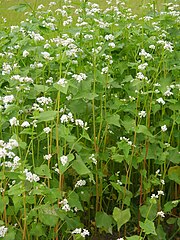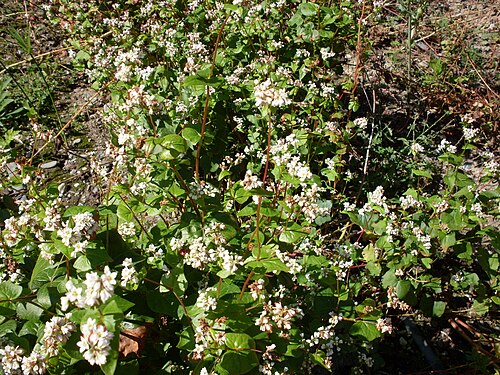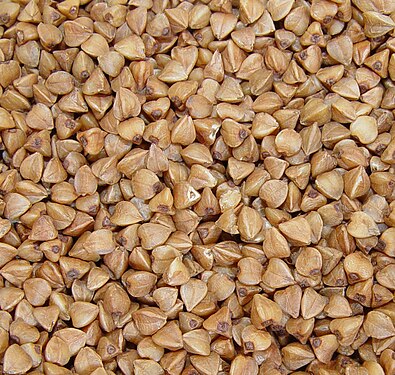Buckwheat
| Habit | herbaceous |
|---|
| Features: | ✓ | edible |
|---|---|---|
| Flower features: | ❀ | white |
|
Moench > |
If this plant info box on watering; zones; height; etc. is mostly empty you can click on the edit tab and fill in the blanks!
Buckwheat refers to plants in two genera of the dicot family Polygonaceae: the Eurasian genus Fagopyrum, and the North American genus Eriogonum. The crop plant, common buckwheat, is Fagopyrum esculentum. Tartary buckwheat (F. tataricum Gaertn.) or "bitter buckwheat" is also used as a crop, but it is much less common. Despite the common name and the grain-like use of the crop, buckwheat is not a cereal or grass. It is called a pseudocereal to emphasize that it is not related to wheat.
The agricultural weed known as Wild Buckwheat (Fallopia convolvulus) is in the same family, but not closely related to the crop species. Within Fagopyrum, the cultivated species are in the cymosum group, with F. cymosum L. (perennial buckwheat), F. giganteum and F. homotropicum.[1] The wild ancestor of common buckwheat is F. esculentum ssp.ancestrale. F. homotropicum is interfertile with F. esculentum and the wild forms have a common distribution, in Yunnan. The wild ancestor of tartary buckwheat is F. tataricum ssp. potanini.[2]
Read about Buckwheat in the Standard Cyclopedia of Horticulture
|
|---|
|
Buckwheat (Fagopyrum esculentum, Moench). Polygonàccse. A tender annual grain plant, flour being made of the large 3-cornered fr. It is much grown in the N. U. S., usually being sown about the first of July. It is also a favorite for bee forage. Buckwheat is native to Cent. Siberia and Manchuria, and is now widely cult., although it is a grain of secondary importance. The Tartarian buckwheat (F. tatáricum, Gaertn.) is occasionally seen. It has smaller and yellowish fls., and a smaller roughish, wavy- angled fr. This species is often confounded with forms of F. esculentum, from which it is really easily distinguished. Buckwheat is a good cleaning crop for weedy and hard lands.
|
Cultivation
Propagation
Pests and diseases
Varieties
Gallery
References
- ↑ T. Sharma, S. Jana (2002). "Species relationships in Fagopyrum revealed by PCR-based DNA fingerprinting". Theoretical and Applied Genetics 105 (2-3): 306–312. doi:10.1007/s00122-002-0938-9. PMID 12582533.
- ↑ Ohnishi, O., Matsuoka, Y. (1996). "Search for the wild ancestor of buckwheat II. Taxonomy of Fagopyrum (Polygonaceae) species based on morphology, isozymes and cpDNA variability". Genes and Genetic Systems 71: 383–390. doi:10.1266/ggs.71.383.
- Standard Cyclopedia of Horticulture, by L. H. Bailey, MacMillan Co., 1963
External links
- w:Buckwheat. Some of the material on this page may be from Wikipedia, under the Creative Commons license.
- Buckwheat QR Code (Size 50, 100, 200, 500)





